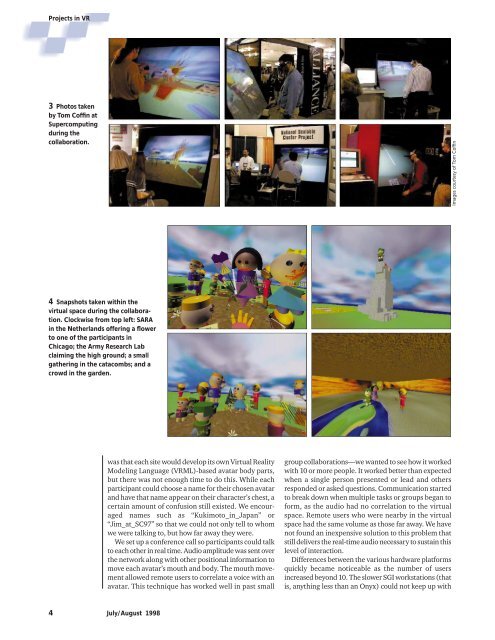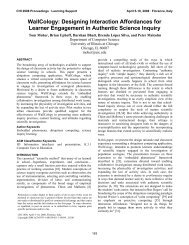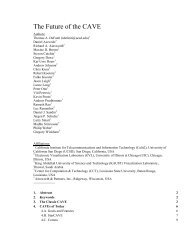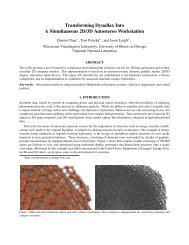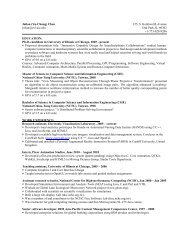Projects in VR - Electronic Visualization Laboratory - University of ...
Projects in VR - Electronic Visualization Laboratory - University of ...
Projects in VR - Electronic Visualization Laboratory - University of ...
You also want an ePaper? Increase the reach of your titles
YUMPU automatically turns print PDFs into web optimized ePapers that Google loves.
<strong>Projects</strong> <strong>in</strong> <strong>VR</strong><br />
3 Photos taken<br />
by Tom C<strong>of</strong>f<strong>in</strong> at<br />
Supercomput<strong>in</strong>g<br />
dur<strong>in</strong>g the<br />
collaboration.<br />
4 Snapshots taken with<strong>in</strong> the<br />
virtual space dur<strong>in</strong>g the collaboration.<br />
Clockwise from top left: SARA<br />
<strong>in</strong> the Netherlands <strong>of</strong>fer<strong>in</strong>g a flower<br />
to one <strong>of</strong> the participants <strong>in</strong><br />
Chicago; the Army Research Lab<br />
claim<strong>in</strong>g the high ground; a small<br />
gather<strong>in</strong>g <strong>in</strong> the catacombs; and a<br />
crowd <strong>in</strong> the garden.<br />
4 July/August 1998<br />
was that each site would develop its own Virtual Reality<br />
Model<strong>in</strong>g Language (<strong>VR</strong>ML)-based avatar body parts,<br />
but there was not enough time to do this. While each<br />
participant could choose a name for their chosen avatar<br />
and have that name appear on their character’s chest, a<br />
certa<strong>in</strong> amount <strong>of</strong> confusion still existed. We encouraged<br />
names such as “Kukimoto_<strong>in</strong>_Japan” or<br />
“Jim_at_SC97” so that we could not only tell to whom<br />
we were talk<strong>in</strong>g to, but how far away they were.<br />
We set up a conference call so participants could talk<br />
to each other <strong>in</strong> real time. Audio amplitude was sent over<br />
the network along with other positional <strong>in</strong>formation to<br />
move each avatar’s mouth and body. The mouth movement<br />
allowed remote users to correlate a voice with an<br />
avatar. This technique has worked well <strong>in</strong> past small<br />
group collaborations—we wanted to see how it worked<br />
with 10 or more people. It worked better than expected<br />
when a s<strong>in</strong>gle person presented or lead and others<br />
responded or asked questions. Communication started<br />
to break down when multiple tasks or groups began to<br />
form, as the audio had no correlation to the virtual<br />
space. Remote users who were nearby <strong>in</strong> the virtual<br />
space had the same volume as those far away. We have<br />
not found an <strong>in</strong>expensive solution to this problem that<br />
still delivers the real-time audio necessary to susta<strong>in</strong> this<br />
level <strong>of</strong> <strong>in</strong>teraction.<br />
Differences between the various hardware platforms<br />
quickly became noticeable as the number <strong>of</strong> users<br />
<strong>in</strong>creased beyond 10. The slower SGI workstations (that<br />
is, anyth<strong>in</strong>g less than an Onyx) could not keep up with<br />
Images courtesy <strong>of</strong> Tom C<strong>of</strong>f<strong>in</strong>


